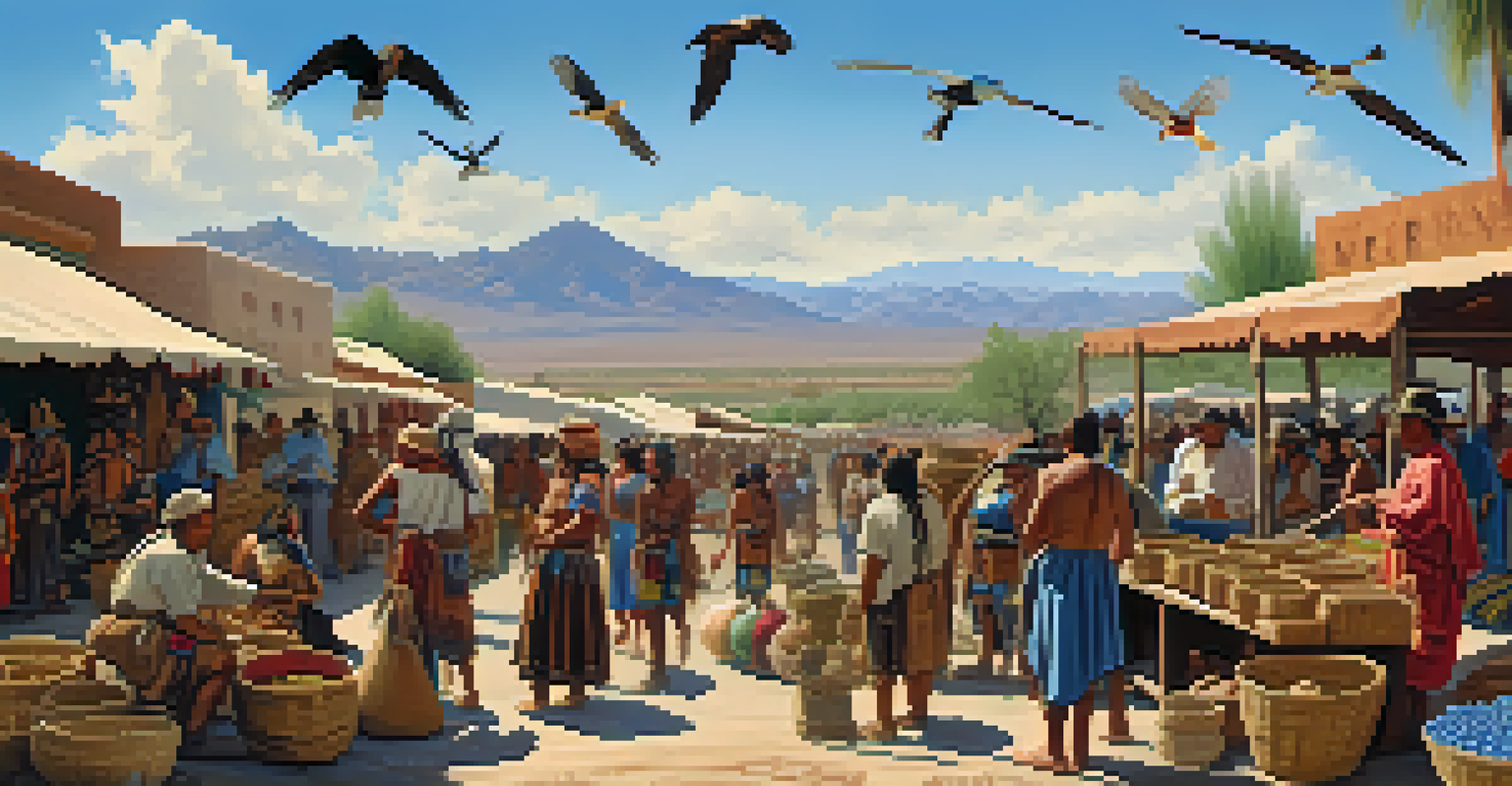The Significance of Tucson in Native American Trade Routes

Tucson: A Historical Crossroads for Native Cultures
Tucson, located in southern Arizona, has long been a pivotal meeting point for various Native American tribes. Its strategic position allowed it to serve as a hub for trade, connecting tribes from different regions. The area's rich resources and favorable climate attracted diverse cultures, making it a melting pot of ideas and goods.
Trade is the lifeblood of culture, connecting communities and fostering relationships that transcend geographic boundaries.
The presence of the Santa Cruz River further enhanced Tucson's appeal, providing a reliable water source. This natural advantage not only supported agriculture but also facilitated transportation and trade. As tribes settled in and around Tucson, they began to establish intricate trade networks that would thrive for centuries.
Moreover, Tucson's significance in Native American history is underscored by archaeological discoveries that reveal evidence of trading practices. These findings illustrate the depth of relationships formed between tribes, highlighting Tucson's role in fostering cultural exchange and economic interdependence.
The Trade Goods That Shaped Relationships
Trade in Tucson was not just about the exchange of goods; it was also about relationships and cultural exchange. Native tribes traded items such as pottery, textiles, and food, each carrying its own significance. For instance, the Hohokam people, known for their advanced irrigation techniques, would exchange agricultural products with tribes from the surrounding regions.

Additionally, precious materials like turquoise and shells were highly sought after, symbolizing wealth and status within tribes. The trade of these goods often led to the establishment of alliances, as tribes sought to strengthen bonds through shared resources. This interconnectedness was crucial for survival in the harsh desert environment.
Tucson: A Trade Hub for Cultures
Tucson's strategic location and resources made it a vital meeting point for various Native American tribes, fostering trade and cultural exchange.
As these trade routes expanded, they also became avenues for the exchange of ideas and customs. The blending of cultures through trade enriched the social fabric of Tucson and helped shape the identities of the tribes involved.
The Role of the Santa Cruz River in Trade
The Santa Cruz River was more than just a water source; it was a lifeline for trade in the Tucson area. Its banks provided fertile land for agriculture, which was a cornerstone of many Native American communities. The river facilitated the movement of goods, making it easier for tribes to engage in trade with one another.
In every exchange, there is a story; in every trade, a thread of connection that weaves the fabric of our shared humanity.
With the river acting as a natural highway, tribes could transport their goods efficiently. This accessibility not only boosted trade volumes but also enabled tribes to interact, fostering a sense of community. The river’s seasonal floods sometimes altered trade routes, but tribes adapted, showcasing their resilience and resourcefulness.
Furthermore, the river's role in trade extended beyond physical goods. It became a cultural symbol, representing the interconnectedness of the tribes that relied on it. The Santa Cruz River stands as a testament to the importance of natural resources in shaping human relationships and economic activities.
Tucson's Influence on Trade Routes Beyond Arizona
Tucson's significance extended beyond its own trade networks; it influenced routes that reached far into Mexico and other parts of the Southwest. As a central point, Tucson facilitated exchanges between diverse tribes, including the Apache and the Tohono O'odham. These connections helped to establish a broader economic landscape that was vital for survival.
Through Tucson, trade routes linked to major centers like Mexico City emerged, allowing for the exchange of goods like cacao and textiles. This not only enriched the local economy but also introduced new cultural elements, such as art and language, into the region. Tucson became a conduit for ideas and products that would shape the cultural heritage of the area.
Santa Cruz River's Vital Role
The Santa Cruz River served as a lifeline for trade, providing fertile land and facilitating the movement of goods among tribes.
The city's role in these expansive trade routes underscores how interconnected the Native American tribes were, as they navigated through vast territories to trade. This interdependence highlights the importance of Tucson as a focal point in the intricate web of trade across the Southwest.
Challenges Faced by Native Traders
While Tucson served as a thriving trade hub, it wasn't without its challenges. Native traders faced obstacles such as environmental conditions, including droughts that could disrupt agriculture. The harsh desert climate often tested the resilience of those who relied on trade for their livelihood.
Additionally, competition between tribes could lead to tensions and conflicts. Traders had to navigate these complex dynamics while also safeguarding their goods. This necessity for vigilance fostered a sense of community among traders, who often shared information and strategies to protect their resources.
Despite these challenges, the spirit of trade persevered. The ability to adapt and innovate in the face of adversity is a hallmark of the Native American tribes that thrived in Tucson, showcasing their strength and determination.
Cultural Exchange Through Trade in Tucson
Trade in Tucson was not just a means of survival but also a rich avenue for cultural exchange. As tribes interacted, they shared stories, traditions, and practices that transcended mere economic transactions. This cultural blending contributed to a unique identity that characterized the region.
For example, the introduction of new agricultural techniques and crops from different tribes led to the diversification of local diets. The sharing of pottery styles and weaving techniques enriched the artistic expressions of the communities. Tucson became a cultural tapestry woven from the threads of various Native American traditions.
Legacy of Cultural Exchange
The rich history of trade in Tucson has shaped its diverse cultural landscape, influencing art, cuisine, and community connections.
This vibrant cultural exchange played a crucial role in shaping the heritage of Tucson. The influences of different tribes created a legacy that continues to be celebrated today, reminding us of the importance of trade in fostering understanding and collaboration.
Modern Implications of Tucson's Trade History
Today, the legacy of Tucson's trade routes is evident in its diverse cultural landscape. The rich history of trade has left an indelible mark on the city's identity, influencing everything from art to cuisine. This historical significance is celebrated through various cultural events that honor the traditions of Native American tribes.
Moreover, the importance of Tucson's trade routes serves as a reminder of the interconnectedness of communities. In a world that often feels divided, the story of Tucson illustrates how collaboration and exchange can lead to thriving societies. Understanding this history can inspire current and future generations to foster connections and promote cultural appreciation.

As Tucson continues to grow, acknowledging its past can guide its future. The resilience of the Native American tribes that once thrived through trade serves as a powerful example of adaptation and unity, encouraging all of us to recognize the value of diverse perspectives.